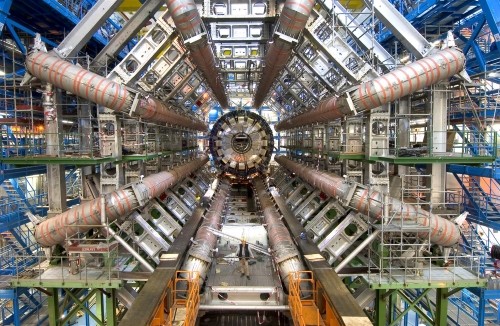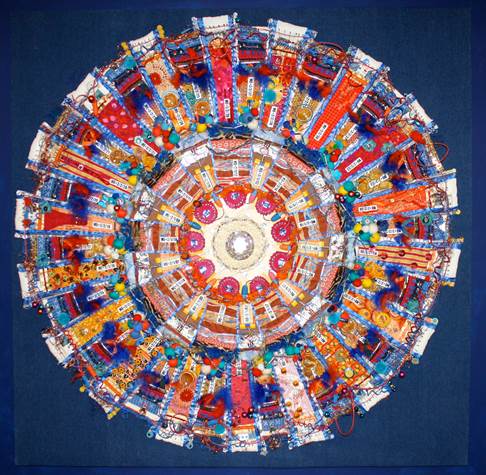Tag archives: CMS
CMS publishes 700 papers, extreme data centres, flat-Earth space programme launches tomorrow

Big data: analysis of CMS papers. See Rao’s article for an interactive version (Courtesy: Achintya Rao/CMS)
By Hamish Johnston
CERN’s CMS collaboration has passed a milestone of sorts at the end of October – it published its 700th research paper. And physicists working on the giant detector on the Large Hadron Collider haven’t stopped there as the tally is now 712 and rising.
CERN’s Achintya Rao has delved into the CMS archives and has chosen his top seven papers. These include the first-ever paper about the detector, which was published in 2008 and, embarrassingly, gets the weight of the detector wrong. Rao has also put together an interactive infographic that looks at 680 papers that analyse data collected by CMS.
View all posts by this author | View this author's profile
‘New boson’ buzz intensifies at CERN, fire prevention in space and Neil Turok on a bright future for physics

ATLAS under construction: has the experiment gone beyond the Standard Model? (Courtesy: ATLAS)
By Hamish Johnston
Excitement levels in the world of particle physics hit the roof this week as further evidence emerged that physicists working on the Large Hadron Collider (LHC) may have caught sight of a new particle that is not described by the Standard Model of particle physics. If this turns out to be true, it will be the most profound discovery in particle physics in decades and would surely lead to a Nobel prize.
View all posts by this author | View this author's profile
CMS on canvas

Collage of the CMS detector at CERN created by Genevieve Lovegrove.
By Michael Banks
We’ve already had a LEGO model of the giant CMS detector at CERN’s Large Hadron Collider (LHC) but now University of Leicester modern literature student Genevieve Lovegrove has attempted to go one better by creating a collage of the LHC detector made from everyday objects.
View all posts by this author | View this author's profile
Maria Spiropulu talks about multiple Higgs beyond the Standard Model
By Hamish Johnston in Waterloo, Canada
Caltech’s Maria Spiropulu has a great party trick. She can demonstrate the bizarre rotational property of a spin ½ particle using a full glass of water and a contortion of her arm without spilling a drop. This was just one of the many highlights of her talk about the future of experimental particle physics that she gave yesterday at the Convergence meeting here at the Perimeter Institute.
While Spiropulu doesn’t talk about spin in the above video, she does explain why she is looking forward to analysing data from the 13 TeV run of the Large Hadron Collider, where she is part of the CMS collaboration. So, what could Spiropulu and colleagues find when they dig into the vast amounts of data that CMS is currently producing? It just could be four more types of Higgs particle. To find out more watch the video.
View all posts by this author | View this author's profile
All hail the Standard Model, once again
By Hamish Johnston
I am a condensed-matter physicist by training and sometimes I struggle to get excited by the latest breakthrough in particle physics – usually because most don’t seem much like breakthroughs to me. The latest hot paper from physicists working on the Large Hadron Collider (LHC) at CERN is a perfect example of what I am talking about.
Writing in Nature this week, physicists working on the CMS and LHCb experiments at CERN announced the discovery of a rare decay of the strange B-meson, as well as further information regarding an even rarer decay of the B0-meson. In both cases the decays produce two oppositely charged muons. An animation of how the strange B-meson decay is detected by the CMS appears in the video above.
View all posts by this author | View this author's profile
CDF bump almost gets a five-star rating

The graph shows the distribution of the “w-jj excess” as seen by the CDF experiment (Courtesy: Punzi/Fermilab)
By Tushna Commissariat
Two months ago, in early April, the particle-physics community was rife with speculation and excitement over a “bump” – a possible new particle – in the data that Fermilab’s CDF experiment was looking at. On Monday 30 May Giovanni Punzi, a CDF collaborator, presented an update on what is now referred to the “ W-jj” bump, as a part of his talk at the 23rd Rencontres de Blois Particle Physics and Cosmology conference currently being held in France. The update says that the bump is seen in more recent data with an even larger statistical significance.
At the time, CDF was looking for slightly rare di-boson pairs – W bosons produced in association with another W or a Z boson. It noted a bump between 120 and 160 GeV /C2 in the jets produced in the collisions with a statistical significance of about “three-sigma”, which meant that the result would not be considered valuable until a “five-sigma” statistical significance could be established. The new data, however, have established a significance that is officially “closer to five sigma” (unconfirmed sources suggest it is as close as 4.8) and that “it was not just a statistical fluctuation” and that it is now a “serious issue for CDF to understand this”, according to Punzi.
Interestingly, Punzi’s slides also say that it is almost impossible that bump is due to the Standard Model top-quark background, as suggested by some theoretical papers, as that would imply that previous measurements for SM top-quark background had huge errors. The next step forward would be if CDF’s sister experiment D0 or the LHC’s ATLAS or CMS experiments, none of which have found the bump in their data so far, manage to detect it.
This updated result has seen a variety of responses from physicists.
Adam Falkowski, who writes the Resonaances blog, seems rather jubilant. “In a collider experiment, such a huge departure from a Standard Model prediction is happening for the first time in the human history,” he writes. “I don’t have to stress how exciting it is.”
Peter Woit, author of the Not Even Wrong blog, feels that while a five-sigma significance is important, problems with background modelling might thwart the result. “The signal is being extracted from a huge background, so a small misunderstanding of the background could be its cause.” Only a detection of the same result by another experiment would make the case more compelling, according to him.
Tommaso Dorigo, a blogger and CDF collaborator, is still sceptical of the result and chalks it up to bad background modelling, like Woit. “No, it is not the Higgs. And it is not a new particle. It is, in my humble opinion, a problem in the modelling of backgrounds, one which was unnoticed before only because it is small enough to have escaped previous attempts at “tuning” the simulations.”, he writes in his blog.
So while it seems like we the path to “new physics” is full of “bumps”, the field of particle physics is a rather exciting one right now! Take a look at the slides Punzi used for his talk here.
View all posts by this author | View this author's profile